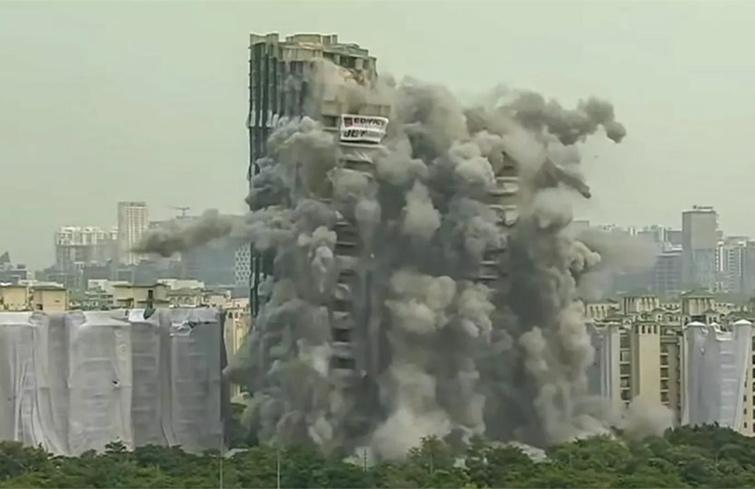 Noida:
Noida: The Supertech twin towers demolished today. The Supertech twin towers in Noida, which were taller than the Qutub Minar, were razed to the ground at 2:30 pm today, nine years after residents went to court alleging violation of norms. 3,700 kg of explosives was used to destroy them.
The demolition of the Emerald Court project in Noida is leading to a loss of about Rs 1,000 crore to developer Supertech. It also took nearly Rs 20 crore to raze the building. So, why have the buildings been razed?
The twin towers (namely Apex and Ceyane) are located at Sector 93A in Noida. One of the buildings has an altitude of 103 metres, while another is around 97-metre tall. For the demolition, about 3,700 kg of explosives were brought from Palwal (Haryana) to be used. It was a mix of dynamite, emulsions and plastic explosives.
The ‘Supertech Emerald Court’ housing society in Noida, in which the two towers are located, was proposed to be built in 2004. The Noida Authority allotted a plot of land measuring 48,263 sq metres, which was a part of Plot No 4 situated in Sector 93A.
In 2005, the Noida Authority sanctioned the building plan for the construction of Emerald Court consisting of 14 towers, each with ground and nine floors (G+9). The construction commenced for these 14 towers.
In June 2006, the total leased area allotted to the company increased to 54,819.51 sq metres. Under the rules, the floor area ratio was also increased from 1.5 to 2 for the new allottees after 2006.
In December 2006, NOIDA sanctioned the first revised plan for the Emerald Court under the NBR 2006, by which two additional floors were added, thereby bringing all of them to ground and 11 floors (G+11). Also, additional buildings were also sanctioned — Tower 15, Tower 16 and a shopping complex.
In 2012, the Noida authority reviewed the new plan, in which the height of the twin towers was fixed at 40 floors.
In August 2021, the Supreme Court ordered the demolition of the structures as their construction violated the minimum distance requirement. According to the court, the buildings were built illegally without taking the consent of the individual flat owners as required under the UP Apartment Act.
The apex court also said Supertech and the Noida Authority engaged in a “nefarious complicity". It then ordered Supertech to demolish the buildings at its expense, under the guidance of the Noida Authority.
In 2014, the court had directed the authority to demolish the buildings within 4 months at its own expense.
The Supreme Court’s decision comes after a number of petitions by homebuyers.
The buildings were to be demolished in May, which later postponed to August 21. Recently, the Supreme Court also extended the deadline to August 28, with a band of 7 days till September 4 due to technical issues and weather conditions.
Meanwhile, eye irritation, dust allergy, bouts of unstoppable coughing and more — the demolition of Noida-based Supertech’s twin towers may lead to several health complications for nearby residents, especially among people with already existing health issues, say experts.
Dense dust and debris are likely to lead to health complications for residents because they will include very tiny particles of debris that can be easily inhaled.
According to Dr Angshuman Mukherjee, a pulmonologist at Fortis Hospital, the blast will lead to immediate as well as delayed health complications.
“The immediate effect will be eye problems, coughing, sneezing and dust allergy. Those who already have lung issues such as asthma and chronic obstructive pulmonary disease (COPD) may witness a bout of illness triggered by the demolition.”
In the next day or two, Mukherjee said, micro particles, including cement dust, could create health issues even among people crossing the area. “Right now, the best option is heavy rain.”
Other experts believe that it may potentially elicit an immune reaction.
“Such allergic reactions may be normal or major depending on the person. Demolition dust can also serve as fomites that potentially carry viruses and infections,” said Dr Navneet Sood, a pulmonologist at Delhi-based Dharamshila Narayana Superspecialty Hospital.
 Noida: The Supertech twin towers demolished today. The Supertech twin towers in Noida, which were taller than the Qutub Minar, were razed to the ground at 2:30 pm today, nine years after residents went to court alleging violation of norms. 3,700 kg of explosives was used to destroy them.
Noida: The Supertech twin towers demolished today. The Supertech twin towers in Noida, which were taller than the Qutub Minar, were razed to the ground at 2:30 pm today, nine years after residents went to court alleging violation of norms. 3,700 kg of explosives was used to destroy them.